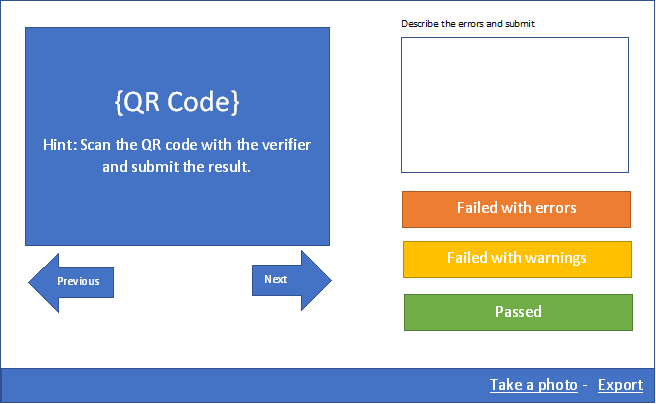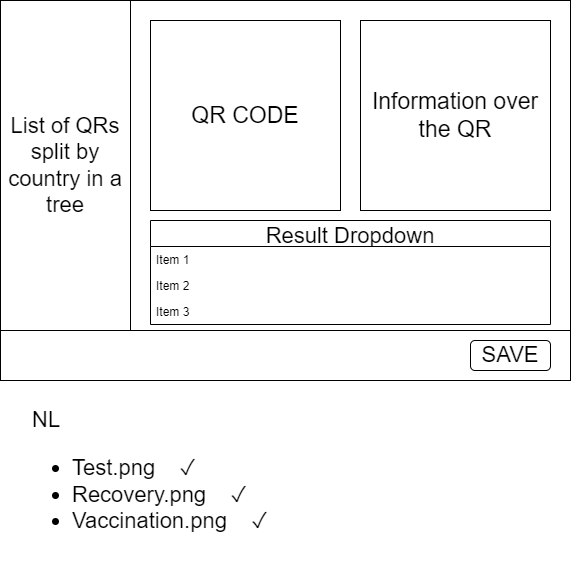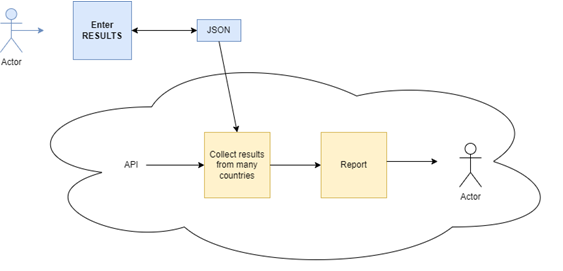EU DCC Validation process
The purpose of this initiative is the automation of the EU DCC validation process.
Introduction
Validation Cycle
During the “Validation Cycle” the member states are using their Verifier App and scan the DCCs in the Quality Assurance repository.
- The scanning process will still take place manually. The suggested, in this place, tools would aim to make it easier and will automate the collections, distribution, and analysis of the results.
Validation Portal
The creation of a Validation Portal is suggested which will:
- Allow easy navigation to all reference QR codes.
- Capture the results from the countries in a comfortable way.
- Export the results in a standard JSON format.
Validation Flow
- The interface pulls the QR codes from GitHub and displays them one by one.
- The user can navigate between the QR codes by using the Previous/Next buttons. The QR codes are also available in a list grouped by Country
- The user uses the Verifier app and scans the QR Code in the display.
- If the Scan gives no errors the user presses the Green (Passed) button.
- If the Scan gives errors or warning the user fills in a copy describing the situation and pressed the amber or red button respectively.
Automation
- The user registers once the MS who uses the Verifier app for.
- The application keeps track of all the submitted data and relates them with the QR Codes.
- The application exports the captured results in JSON.
- The application would provide the option for the user to take a photo of the verifier app showing the error message. The application will store these images and will relate them to the results.
Result format
Test results are provided one json file per platform.
{
metadata: {
country: "XX",
date-completed: "20220120T102611Z",
commit-tested: "4699f4b13a1010d10d9c4f80eac59beec5cbb613",
platform-tested: "IOS|ANDROID"
},
results: [{
"file": "NL/1.3.0/REC.png",
"result": "Valid|Invalid|Error",
"comment": "Free text"
},{
"file": "NL/1.3.0/REC.png",
"result": "Valid|Invalid|Error",
"comment": "Free text"
}]
}
-
metadata: contains various metadata. -
``: country code, iso-two-letter code
-
``: date the test was completed, in ISO8601 UTC
-
``: git hash of the commit tested
-
``: platform the tests were done on
-
results: contains an array of results, one per file -
file: the relative path to the test file from the root of the QA repository. this path is returned by the github API if you use that. -
result: the test result,Validfor valid,Invalidif the DCC was scanned but deemed invalid,Errorif the DCC did not scan. -
comment: optional free text explaining the result if it isn'tValid
The file name contains the country code, the test date and the platform:
YYYYDDMM-XX-PLATFORM.json
So for NL tests conducted on 2022-01-17 you have these two files (for both platforms):
20220117-NL-ANDROID.json
20220117-NL-IOS.json
Schema
The results.json should satisfy the results.schema.json
Client / Server architecture
Planning and Roadmap
Visit the EU DCC Validation Planning project
Development instructions
This project was generated with Angular CLI version 13.1.3.
Development server
Run ng serve for a dev server. Navigate to http://localhost:4200/. The app will automatically reload if you change any of the source files.
Code scaffolding
Run ng generate component component-name to generate a new component. You can also use ng generate directive|pipe|service|class|guard|interface|enum|module.
Build
Run ng build to build the project. The build artifacts will be stored in the dist/ directory.
Running unit tests
Run ng test to execute the unit tests via Karma.
Running end-to-end tests
Run ng e2e to execute the end-to-end tests via a platform of your choice. To use this command, you need to first add a package that implements end-to-end testing capabilities.
Further help
To get more help on the Angular CLI use ng help or go check out the Angular CLI Overview and Command Reference page.
Discussion
Have an idea, a question or a comment to share?
- Start a discussion: https://github.com/skounis/eu-dcc-validation/discussions/
- Join lfph.io in Slack: https://lfpublichealth.slack.com/
Contributors
Made with contrib.rocks.
Licensing
Copyright (c) 2022 Stavros Kounis (Directorate-General CONNECT), Ryan Barrett (Dutch Ministry of Health, Science, and Sports), Sofia Atsalou and all other contributors
Licensed under the EUROPEAN UNION PUBLIC LICENCE v. 1.2 (the "License"); you may not use this file except in compliance with the License.
You may obtain a copy of the License at https://joinup.ec.europa.eu/collection/eupl/eupl-text-eupl-12.
Unless required by applicable law or agreed to in writing, software distributed under the License is distributed on an "AS IS" BASIS, WITHOUT WARRANTIES OR CONDITIONS OF ANY KIND, either express or implied. See the LICENSE for the specific language governing permissions and limitations under the License.






